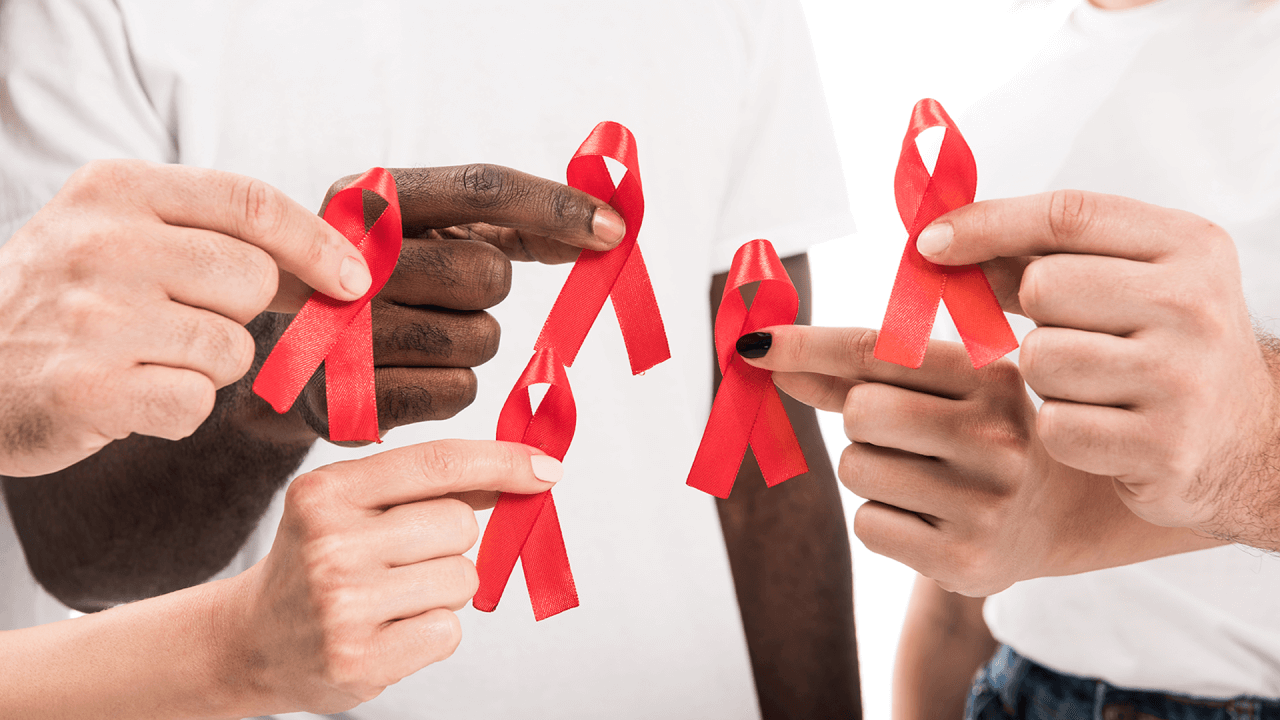World AIDS Day takes place each year on December 1st to commemorate the lives of people who have died of AIDS, as well as to show support to the 39 million people who live with HIV.(1,2) Although feelings of somberness underlie the commemorative nature of the event, the development of antiretroviral drugs and improved support for people living with HIV are sources of hope for the future.
On this globally recognized international health awareness day, we can revisit the 95-95-95 initiative that was created by the Joint United Nations Programme on HIV/AIDS (UNAIDS).(3) The aims of this initiative are, by 2025, for 95% of all individuals with HIV to receive a diagnosis, 95% of diagnosed individuals to receive treatment and 95% of people who are being treated to achieve suppression of their viral load.(4)
Meeting these goals requires a multipronged approach to combat stigma and discrimination against HIV-infected people, as well as optimize access to a wide range of antiretroviral therapies.The theme for this year’s World AIDS Day is ‘Let Communities Lead’: an effort to recognize the important role of people who are affected by HIV in coordinating the global response to the pandemic.(5) Healthcare providers in communities where HIV transmission rates are high have deep knowledge of the challenges that face infected individuals.
Community-based approaches are critical in building trust and ensuring that medication is supplied to those who require treatment.(5) There are organizations that work to address challenges in this area, such as funding shortages, legal barriers, scarcity of qualified healthcare professionals, and discrimination against marginalized groups.(5) In the US, for example, the Centers for Disease Control and Prevention (CDC) developed a scheme to prioritize the use of evidence-based approaches to prevent transmission of HIV in demographics with the highest risk of contracting the infection.(6) Furthermore, by re-evaluating how funds are distributed in health departments and community-based organizations, healthcare providers are able to give low-income uninsured individuals access to antiretroviral therapies, HIV testing, and other social services.(6)
Community pharmacies in the Netherlands have distributed HIV self-testing kits since 2019, allowing individuals to take the test in a private setting.(4) This approach can help those who are reluctant to get tested in clinical practice. Other European countries such as Germany and Spain employ harm reduction strategies to reduce HIV transmission among people who inject recreational drugs.(7,8)
In the Asia-Pacific region, a significant percentage of HIV infections occur through sexual contact. One community-led educational program in Thailand involved training local police to understand the issues that face people who work in the sex industry. This led to the police promoting condom use, which is known to reduce transmission of HIV.(9,10)
In South America, ImPrEP is an initiative that works to prevent contraction of HIV by providing same-day pre-exposure prophylaxis to people who have been identified as having an increased risk of becoming infected.(11)
More than 25 million people in Africa were living with HIV in 2022.(12) Stigma, insufficient resources, inadequate training of medical personnel, and suboptimal infrastructure for monitoring HIV transmission within specific communities, pose major challenges to addressing the epidemic.(13) The effectiveness of community-based care in this region is evidenced through a report from the Christian Council of Mozambique. Home visits by community health workers, antenatal counseling, and administration of medication to prevent transmission of the virus, led to seronegativity in a child born to an HIV-infected mother.(14)
The Christian Community of Sant’Egidio which also operates in Mozambique, runs a community initiative known as DREAMS (Determined, Resilient, Empowered, AIDS-Free, Mentored, and Safe).(15) Through providing antiretroviral therapy to more than 4800 people, the scheme has led to significant improvements in the lives of people living with HIV.(16) The DREAMS program provides voluntary counseling in eight centers and has achieved a high rate of seronegativity in children born to HIV-infected mothers in the program. A sample looking at more than 1500 babies found that only 3% of babies tested positive for the virus.(16)
It is increasingly understood that effective community-centered care will play a pivotal role in tackling the HIV/AIDS pandemic. Improving access to life-preserving medications, testing facilities, and nonjudgmental fact-based educational programs are some of the strategies that will promote progress toward achieving the UNAIDS 95-95-95 target. Early diagnosis, administration of effective medications, and elimination of prejudice and discrimination will contribute to an improvement in the quality of life of people living with HIV. Recognizing the positive impact that community-based care can have on at-risk individuals should highlight the urgency of addressing the gaps that threaten our progress in the fight against HIV/AIDS.
References
- World Health Organization (WHO). HIV. Available from: https://www.who.int/data/gho/data/themes/hiv-aids. Last accessed November 2023.
- United Nations. World AIDS Day. Available from: https://www.un.org/en/observances/world-aids-day. Last accessed November 2023.
- World Health Organization (WHO). World AIDS Day. Available from: https://www.who.int/westernpacific/news-room/events/world-aids-day. Last accessed November 2023.
- Kandil C, et al. Availability and accessibility of HIV self-tests and self-sample kits at community pharmacies in the Netherlands. AIDS Res Ther. 2023;20(1):39.
- The Joint United Nations Programme on HIV and AIDS (UNAIDS). World AIDS Day. Available from: https://www.unaids.org/en/2023-world-aids-day. Last accessed November 2023.
- Shapatava E, et al. Community-based organization adaptations to the changing HIV prevention and care landscape in the Southern United States. AIDS Educ Prev. 2018;30:516-27.
- Castro-Granell V, et al. Recreational drug use in people living with HIV in Spain: factors associated with drug use and the impact on clinical outcomes. AIDS Behav. 2021;25:3883-97.
- KPMG. Ending the Epidemic. Available from: https://assets.kpmg.com/content/dam/kpmg/uk/pdf/2019/03/ending-the-hiv-epidemic-german-report.pdf. Last accessed November 2023.
- Choi JY, et al. Overcoming challenges across the HIV care continuum in the Asia-Pacific region: expert recommendations. BMJ Glob Heal. 2023;8(7):e012722.
- Centers for Disease Control and Prevention (CDC). What are condoms? Available from: https://www.cdc.gov/hiv/basics/hiv-prevention/condoms.html. Last accessed November 2023.
- Luz PM, et al. The HIV epidemic in Latin America. Curr Opin HIV AIDS. 2019;14:366-73.
- The Joint United Nations Programme on HIV and AIDS (UNAIDS). World AIDS Day 2023. Fact sheet: Global HIV statistics. Available from: https://www.unaids.org/sites/default/files/media_asset/UNAIDS_FactSheet_en.pdf. Last accessed November 2023.
- Ngcobo S, et al. Roles, barriers, and recommendations for community health workers providing community-based HIV care in sub-Saharan Africa: A Review. AIDS Patient Care STDS. 2022;36(4):130-44.
- USAID. Community-based organizations in the fight against HIV. Available from: https://www.usaid.gov/mozambique/news/jun-08-2023-community-based-organizations-fight-against-hiv. Last accessed November
- US Embassy in Mozambique – Celebrating 5 Years of DREAMS. Available from: https://mz.usembassy.gov/our-relationship/pepfar-us-presidents-emergency-plan-for-aids-relief-2/dreams/. Last accessed November 2023.
- Development Dialogue on Values and Ethics Unit, The World Bank. Faith leaders and institutions in Mozambique’s HIV/AIDS strategy. Available from: https://s3.amazonaws.com/berkley-center/07022DDVEFaithLeadersInstitutionsMozambiqueHIVAIDSStrategy.pdf. Last accessed November 2023.




